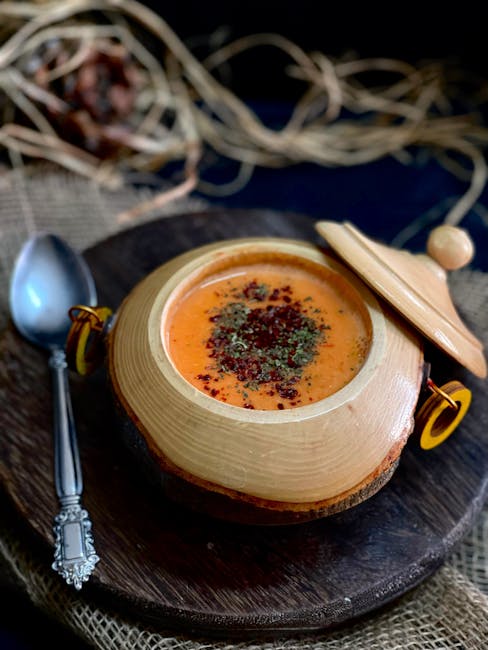Prepare yourself for a culinary journey to the heart of Turkey with a bowl of Perfect Turkish Tarhana Soup. This isn’t just any soup; it’s a testament to centuries of culinary tradition and resourcefulness. Tarhana’s origins are deeply rooted in Anatolian history, dating back to the Seljuk period (11th-13th centuries). While precise documentation is scarce for such an ancient food, its presence in historical texts and its enduring popularity across diverse Turkish communities strongly suggest its longevity and cultural importance. The soup’s enduring legacy speaks to its practicality – a way to preserve seasonal harvests for leaner times, a characteristic crucial in a region experiencing diverse climates.
The very essence of tarhana lies in its unique preparation. It’s a fermented soup base, typically made from a mixture of yogurt, flour (often wheat or barley), and tomatoes, sometimes with the addition of herbs and spices like mint or red pepper flakes. This fermentation process not only preserves the ingredients but also enhances their nutritional value and complexity of flavor. The resulting dried granules can be stored for months, providing a readily available and nutritious base for a quick and hearty soup, perfect for cold winter evenings or a revitalizing lunch. Estimates suggest that over 80% of Turkish households have their own unique tarhana recipe, passed down through generations, highlighting the soup’s deeply personal and familial significance.
Beyond its practical uses, tarhana soup holds a significant place in Turkish culture. It’s not merely sustenance; it’s a symbol of home, family, and tradition. Many families consider their tarhana recipe a closely guarded secret, a culinary heirloom passed down from grandmothers to mothers to daughters. The process of making tarhana itself is often a communal affair, bringing family members together in a shared culinary experience. Furthermore, regional variations abound, reflecting the rich diversity of Turkish cuisine. From the spicier versions found in southeastern Turkey to the milder variations of the Aegean coast, each bowl tells a story of its origin and the unique culinary landscape of its region. The soup’s popularity extends beyond Turkey’s borders, finding its way into the kitchens of Turkish diaspora communities worldwide, serving as a powerful link to their heritage.
The nutritional profile of tarhana is equally impressive. Being a fermented food, it’s a rich source of probiotics, beneficial for gut health. The combination of grains, yogurt, and vegetables provides a balanced source of carbohydrates, protein, and vitamins. Its relatively low calorie count, coupled with its high fiber content, makes it a nutritious and satisfying option for a healthy diet. This, combined with its historical significance and cultural value, solidifies tarhana soup’s place not just as a food, but as a vital part of the Turkish culinary heritage.
Ingredients and Measurements for Perfect Turkish Tarhana Soup
This recipe yields approximately 6-8 servings of delicious and hearty Turkish Tarhana Soup. The quantities listed below are a guideline; feel free to adjust them based on your personal preferences and the number of servings you require. Accurate measurements are crucial for achieving the perfect consistency and flavor.
For the Tarhana (can be made ahead or purchased):
- 2 cups dried yogurt (preferably whole milk, you can also use a mix of yogurt and kefir for a tangier flavor) – Ensure the yogurt is completely dried and crumbly. If it’s too moist, it will affect the soup’s texture.
- 1 cup cracked wheat (bulgur) – Using fine bulgur will result in a smoother soup. Coarse bulgur will give a more rustic texture.
- 1 cup flour (all-purpose or a blend with whole wheat for added nutrients) – Using a good quality flour will enhance the overall flavor
- 1 teaspoon red pepper flakes (pul biber) – Adjust to your spice preference. Start with less and add more to taste, as pul biber can be quite potent.
- 1 teaspoon dried mint – Fresh mint can also be used, but dried mint holds its flavor better during the drying and storage process of the tarhana.
- 1/2 teaspoon ground cumin – Adds warmth and depth of flavor.
- Salt to taste (approximately 1-2 teaspoons) – Add salt gradually, tasting as you go. The amount will depend on the saltiness of the yogurt.
For the Soup:
- 1 large onion, finely chopped (approximately 1 cup) – Sautéing the onion until translucent is crucial for developing its flavor.
- 2 tablespoons olive oil – Use a good quality extra virgin olive oil for the best flavor.
- 1 cup chopped tomatoes (fresh or canned, diced) – Fresh tomatoes will give a fresher taste. If using canned, drain well.
- 2 carrots, peeled and diced (approximately 1 cup) – Carrots add sweetness and color to the soup.
- 1 cup lentils (red or brown, your preference) – Red lentils cook faster and will create a smoother soup. Brown lentils provide a more hearty texture.
- 6 cups water or vegetable broth – Vegetable broth will enhance the overall flavor.
- 1/2 cup tarhana (the homemade mixture or store-bought) – Adjust the amount of tarhana to achieve your desired thickness.
- Freshly chopped parsley for garnish (optional) – Adds a fresh, vibrant touch to the finished soup.
- Lemon wedges for serving (optional) – A squeeze of lemon juice brightens the flavors.
Important Note: If making your own tarhana, ensure it is thoroughly dried before storing. Proper drying prevents mold and ensures a long shelf life. Store in an airtight container in a cool, dry place.
Professional Recommendation: For a richer and creamier soup, you can blend a portion of the cooked soup before serving, leaving some texture for a more interesting mouthfeel.
Preparation of Vegetables and Grains
The success of a perfect Turkish Tarhana soup hinges significantly on the meticulous preparation of its vegetables and grains. This stage sets the flavor foundation, so take your time and pay attention to detail.
We’ll begin with the grains. For this recipe, we’ll use 1 cup of bulgur wheat. Before incorporating it into the soup, it’s crucial to rinse the bulgur thoroughly under cold running water. This removes any excess starch and ensures a cleaner, lighter flavor in the final soup. Rinse for at least 2-3 minutes, gently swirling the bulgur in the water until the water runs clear. This step is often overlooked but makes a noticeable difference.
Next, we’ll prepare the vegetables. The vegetables are the heart of the Tarhana’s flavor profile. We’ll need: 2 large onions, 2 medium carrots, 2 celery stalks, and 2 cloves of garlic. Precise measurements aren’t as critical here, but maintaining a balance between the vegetables is important. Start by peeling the onions and carrots thoroughly. Then, finely chop the onions. Rough chopping will work, but finer chopping allows for better integration into the soup and prevents large chunks from dominating the texture.
The carrots should be diced into small, roughly half-centimeter cubes. This ensures they cook evenly and contribute to the overall texture of the soup. Similar to the carrots, finely chop the celery stalks. Aim for a consistent size to make sure all your vegetables cook at the same pace. Finally, mince the garlic cloves finely. Their pungent aroma is crucial to the Tarhana’s overall flavor profile, so don’t skimp on this step!
Professional Tip: Consider using a food processor for chopping the vegetables if you want a more consistent size and texture. However, be careful not to over-process the vegetables, as this can release too much moisture and affect the soup’s consistency. A quick pulse is sufficient.
For added depth of flavor, consider adding other vegetables. A finely chopped green bell pepper (about ½ cup, diced) adds a subtle sweetness and vibrant color. Similarly, a small amount of fresh parsley (about ¼ cup, chopped) can be added at the end for a fresh, herbaceous note. Experiment with different vegetable combinations to find what suits your palate best.
Important Note: The quality of your vegetables will directly impact the taste of your Tarhana soup. Choose fresh, high-quality ingredients whenever possible. Stale or wilted vegetables will significantly compromise the overall flavor of the final product. Proper preparation, as outlined above, will ensure your Tarhana soup is not only delicious but also visually appealing.
Fermentation Process: The Heart of Tarhana
The fermentation process is the cornerstone of a truly exceptional Turkish Tarhana soup. It’s where the magic happens, transforming simple ingredients into a complex and flavorful broth. This process requires patience and attention to detail, but the rewards are well worth the effort. We’ll guide you through each step to ensure your tarhana ferments perfectly.
Preparing the Mixture: Begin by combining 1 kg of cooked, mashed tomatoes (about 4-5 large tomatoes), 500g of cooked bulgur wheat (use fine bulgur for a smoother texture), 250g of plain yogurt (full-fat is recommended for richer flavor and better fermentation), and 100g of finely chopped fresh parsley. Add 2 tablespoons of salt. Thoroughly mix all ingredients until a homogenous paste is formed. The consistency should be thick but still manageable to stir. Too much liquid will hinder fermentation, while too little will result in a dry, hard tarhana.
The Fermentation Vessel: Choose a clean, food-grade container for fermentation. Glass or food-grade plastic are ideal. Avoid using metal containers as they can react with the acidic components of the mixture. The container should be large enough to accommodate the mixture, leaving about 2 inches of headspace to allow for expansion during fermentation. Ensure the container is sterilized thoroughly before use to prevent unwanted bacterial growth.
Initiating Fermentation: Once the mixture is prepared and the container is ready, transfer the mixture into the container. Cover the container loosely with a clean cloth or cheesecloth, secured with a rubber band. This allows for air circulation, which is crucial for the lactic acid bacteria to thrive. Do not seal the container airtight. Place the container in a warm, dark place with a consistent temperature between 20-25°C (68-77°F). Fluctuations in temperature can negatively impact the fermentation process.
Monitoring the Fermentation: The fermentation process typically takes 2-3 days, but this can vary depending on the ambient temperature and the activity of the bacteria. Observe the mixture daily. You’ll notice bubbling and a sour, tangy aroma developing. This is a sign that fermentation is progressing well. If you notice any unusual molds or off-putting odors, discard the mixture immediately.
Testing for Acidity: After 2-3 days, test the acidity of the mixture using pH strips. The ideal pH range should be between 4.0 and 4.5. If the pH is higher, allow the fermentation to continue for another day or two. If the pH is lower, you can proceed to the drying stage. Using a pH meter ensures optimum fermentation.
Drying the Tarhana: Once the desired acidity is achieved, spread the fermented mixture thinly onto clean, sterilized trays or baking sheets. Ensure the layer is thin to allow for even drying. Dry the tarhana in a well-ventilated, shaded area for 5-7 days or until completely dry and crumbly. Turn the tarhana regularly to ensure even drying and prevent spoilage. Avoid direct sunlight, as this can degrade the flavor and color.
Storage: Once completely dry, store the tarhana in airtight containers in a cool, dry place. Properly stored tarhana can last for several months, even up to a year, maintaining its flavor and nutritional value. Always ensure the tarhana is completely dry before storing to prevent mold growth.
Drying the Tarhana
Drying tarhana is a crucial step that determines its shelf life and ultimate flavor. Proper drying prevents spoilage and ensures a long-lasting, delicious soup base. This process can take anywhere from a few days to a couple of weeks, depending on the humidity and temperature of your environment. Consistency is key: ensure even drying to prevent mold growth.
Once you’ve thoroughly mixed your tarhana mixture (following the recipe instructions for the previous steps), you need to prepare it for drying. The consistency should be similar to a thick, slightly crumbly paste. If it’s too wet, it will take longer to dry and be more prone to molding. If it’s too dry, it will crumble excessively and may not reconstitute well later. Aim for a consistency that holds its shape when formed into small, roughly 1-inch balls or flat, thin patties.
For optimal drying, spread the tarhana mixture thinly onto clean, large trays or baking sheets. Avoid overcrowding; leave ample space between each ball or patty (at least ½ inch) to allow for proper air circulation. Line your trays with parchment paper or silicone baking mats for easy removal. Approximately 2-3 kilograms of tarhana mixture will require at least three large baking sheets (18 x 26 inches).
The drying environment is critical. Direct sunlight is generally discouraged, as it can cause the tarhana to become overly dry and brittle, affecting its flavor and texture. Instead, opt for a well-ventilated, shaded area with low humidity. A warm, dry room, a screened porch, or even a dehydrator (set to a low temperature) can work well. Avoid locations prone to dust or insects.
The drying time depends heavily on environmental conditions. In ideal conditions (warm, dry, and well-ventilated), it might take 3-5 days. However, in humid climates, it could take up to 2 weeks. Regularly check the tarhana for dryness. It should be completely hard and crumbly, with no soft or moist spots. Turn the tarhana balls or patties occasionally to ensure even drying. You can gently press on them to test their dryness – if they don’t feel soft at all, they are ready.
Once completely dry, store your tarhana in airtight containers in a cool, dark, and dry place. Proper storage is essential for preserving its quality and preventing spoilage. Glass jars or food-grade plastic containers with tight-fitting lids are ideal. With proper drying and storage, your homemade tarhana can last for several months, even up to a year.
Important Note: If you notice any signs of mold or discoloration during the drying process, discard the affected portions immediately to prevent contamination of the entire batch. Mold growth indicates improper drying or storage conditions.
Making the Soup Broth
The foundation of a truly perfect Turkish Tarhana Soup lies in its rich and flavorful broth. This isn’t a quick process, but the depth of flavor it yields is well worth the effort. We’ll be building a complex broth from scratch, using a combination of vegetables and spices to create a deeply satisfying base for your tarhana.
Begin by gathering your ingredients: 2 large carrots (roughly 200g), 2 celery stalks (about 150g), 1 large onion (approximately 150g), 4 cloves garlic (minced), 2 tablespoons of tomato paste, 1 teaspoon of ground cumin, ½ teaspoon of ground coriander, ¼ teaspoon of red pepper flakes (adjust to your spice preference), 1 bay leaf, 6 cups (1.4 liters) of chicken or vegetable broth (choose based on your dietary preference), and 2 liters (8 cups) of water. Using high-quality broth significantly impacts the final taste; don’t skimp here!
Start by preparing your vegetables. Peel and roughly chop the carrots, celery, and onion. The size doesn’t need to be precise; we’re aiming for even cooking rather than perfectly uniform pieces. Avoid overly small pieces, as they can easily overcook and become mushy.
In a large, heavy-bottomed pot or Dutch oven, heat 2 tablespoons of olive oil over medium heat. Add the chopped onions and cook until softened and translucent, about 5-7 minutes. This step is crucial for developing a deep, savory flavor. Don’t rush this process; low and slow is key.
Next, add the chopped carrots and celery to the pot. Cook for another 5-7 minutes, stirring occasionally, until slightly softened. Then, add the minced garlic, tomato paste, cumin, coriander, and red pepper flakes. Cook for another minute, stirring constantly, to toast the spices and release their aromas. This toasting step adds a significant layer of complexity to the broth’s flavor profile.
Pour in the chicken or vegetable broth and water. Add the bay leaf. Bring the mixture to a boil, then reduce the heat to low, cover, and simmer for at least 45 minutes, or even up to an hour. The longer it simmers, the richer and more flavorful your broth will become. During simmering, skim off any foam or impurities that rise to the surface for a clearer broth.
Once the broth has simmered sufficiently, remove it from the heat and carefully remove the bay leaf. Using an immersion blender (or carefully transferring the broth to a regular blender in batches), partially puree the soup. Do not completely puree the broth; you want to leave some texture for a more interesting mouthfeel.
Your flavorful broth is now ready to be used as the base for your perfect Turkish Tarhana Soup. Strain the broth through a fine-mesh sieve if you prefer a completely smooth texture, discarding the solids. Taste and adjust seasoning as needed, adding salt and pepper to your preference.
Cooking the Tarhana Soup
Now that your delicious tarhana is ready, let’s dive into making a hearty and flavorful soup. This recipe yields approximately 6 servings. Adjust quantities as needed for your group.
Ingredients:
- 2 cups dried tarhana
- 8 cups water (or vegetable broth for a richer flavor)
- 1 large onion, finely chopped
- 2 cloves garlic, minced
- 1 tablespoon tomato paste
- 1 teaspoon red pepper flakes (optional, adjust to your spice preference)
- 1/2 cup chopped fresh tomatoes (or 1/4 cup canned, diced tomatoes)
- 1/2 cup chopped fresh parsley
- 1/4 cup chopped fresh dill
- 2 tablespoons olive oil
- Salt and black pepper to taste
- 1 cup bulgur (optional, for a heartier soup)
- 1 cup lentils (optional, for added protein and texture)
Instructions:
1. Sauté the aromatics: Heat the olive oil in a large pot or Dutch oven over medium heat. Add the chopped onion and sauté for about 5 minutes, until softened and translucent. Add the minced garlic and tomato paste and cook for another minute, stirring constantly, until fragrant. Don’t let the garlic brown; this will make it bitter.
2. Bloom the spices (optional): If using red pepper flakes, add them to the pot along with the garlic and tomato paste and cook for 30 seconds, stirring continuously, to release their flavor. Be cautious with the red pepper flakes, as their spiciness can vary greatly.
3. Add the tarhana and liquid: Gradually whisk in the dried tarhana into the pot, ensuring there are no lumps. Slowly pour in the water (or broth), stirring constantly to prevent clumping. Bring the mixture to a boil, then reduce the heat to low, cover, and simmer for at least 20 minutes, or until the tarhana is fully cooked and the soup has thickened. Stir occasionally to prevent sticking.
4. Add optional ingredients: If using bulgur or lentils, add them to the soup during the last 15-20 minutes of simmering time. Make sure they are cooked through before serving.
5. Season and finish: Stir in the chopped fresh tomatoes, parsley, and dill. Season with salt and black pepper to taste. Taste and adjust seasonings as needed. Some prefer a more tart soup, so you may want to add a squeeze of lemon juice at the end.
6. Serve: Ladle the hot tarhana soup into bowls and serve immediately. It’s delicious on its own, or you can serve it with a dollop of yogurt or a crusty piece of bread for dipping.
Professional Recommendations:
- For a smoother soup, you can blend a portion of the cooked soup with an immersion blender before serving.
- If your tarhana is particularly thick, you may need to add more water to achieve your desired consistency.
- Feel free to experiment with other vegetables, such as carrots, celery, or zucchini, to add more depth of flavor.
- Leftovers can be stored in the refrigerator for up to 3 days.
Enjoy your homemade Turkish Tarhana Soup!
Recommendations for Perfect Turkish Tarhana Soup
To fully enjoy your Perfect Turkish Tarhana Soup, we recommend following these guidelines for optimal taste and experience. Start by serving your soup piping hot, allowing the rich flavors to fully bloom and the aromas to tantalize your senses. The slight tanginess and hearty texture are best appreciated when warm. For a truly authentic experience, consider serving it in traditional, rustic bowls.
Serving Suggestions: A dollop of plain yogurt or a drizzle of high-quality olive oil adds a creamy richness and cuts through the slightly tart flavor profile of the soup. A sprinkle of fresh herbs, such as finely chopped dill or parsley, provides a vibrant pop of color and freshness. A squeeze of lemon juice at the table allows for individual customization of tartness. For a heartier meal, consider adding cooked bulgur wheat or small pieces of leftover roasted chicken or lamb during the final simmering stage. These additions will increase the satiety and nutritional value.
Storage: Leftover Tarhana soup, if stored properly, can retain its deliciousness for several days. Allow the soup to cool completely before storing it in an airtight container in the refrigerator. It should be stored for no more than 3-4 days to maintain its freshness and prevent bacterial growth. Avoid repeated freezing and thawing as it can affect the texture and flavor of the soup. When reheating, gently warm the soup on the stovetop or in the microwave, avoiding high heat that can cause scorching.
Complementary Dishes: Tarhana soup is a versatile dish that pairs well with a variety of accompaniments. A simple green salad with a light vinaigrette offers a refreshing contrast to the hearty soup. Warm, crusty bread is ideal for soaking up the flavorful broth. Other great pairings include grilled or roasted vegetables, such as zucchini, eggplant, or bell peppers. For a more substantial meal, consider serving it alongside a plate of dolma (stuffed vegetables) or a small portion of lentil salad. These dishes complement the soup’s robust flavors without overpowering them.
Nutritional Information (per serving, approximate): The exact nutritional content will vary depending on the specific ingredients and quantities used. However, a typical serving of Tarhana soup is relatively low in fat and high in fiber, providing a good source of complex carbohydrates and protein. A single serving (approximately 250ml) is estimated to contain approximately 200-250 calories, 10-15g of protein, 30-40g of carbohydrates, and 5-8g of fiber. It’s also a good source of vitamins and minerals, depending on the vegetables included in the recipe. Please note that these are estimates, and the actual nutritional content may vary.
By following these recommendations, you can elevate your experience of Perfect Turkish Tarhana Soup and enjoy its rich flavors and nutritional benefits to the fullest. Remember to adjust the seasonings and additions to suit your individual preferences and dietary needs.




